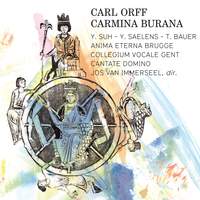Recording of the Week,
Jos van Immerseel conducts Carmina Burana
It can often be interesting to hear a familiar work interpreted in a new way, and that’s certainly the case with a recording due out next week of Carl Orff’s most famous piece, Carmina Burana, conducted by Jos van Immerseel.
I say ‘familiar’, although I suppose really it’s mostly known for the chorus that opens and closes the work, O Fortuna, made incredibly familiar through its use in countless films and television advertisements. The full work consists of settings of twenty-four medieval poems, mostly in Latin or Middle High German, and frequently on topics of an extremely bawdy, ribald nature!

Although the piece is usually the province of huge choral societies, Immerseel here uses the instrumental forces of Anima Eterna Brugge and the vocal talents of Collegium Vocale Gent to present a pared-down version with a choir of just thirty-six singers. As you can see from the image here, the size of the orchestra’s string section is reduced too: Immerseel talks in the booklet notes about the relatively modest role that the strings play in this piece, and how he wanted to focus on the unusual, imaginative wind and brass sonorities that Orff employs throughout the work.
He has attempted as far as possible to use instruments from around the time of the work’s composition in order to get close to the sort of sound that Orff would have had in mind when he wrote the work in the 1930s. It definitely has a striking effect - if you’re used to hearing a massive choir in this piece then the opening of this recording will certainly come as a surprise. With the reduced string size, instruments that normally get a bit lost are heard with ease, and far from creating a lack of impact, the small choral size adds a wonderful clarity throughout the piece, enabling the rhythmic intricacies to come across very well indeed.
As well as the main choir (and indeed a children’s chorus that pops up from time to time), the piece also calls for three soloists. A feature common to all three of these solo parts is the demand placed upon them by Orff in terms of the required singing range, and this is certainly true of the only movement to call for a solo tenor, Olim lacus colueram. It is one of the work’s more bizarre numbers: the tenor is the voice of a swan that is slowly being roasted on a spit, pining for happier days at home on the lake and lamenting his current chargrilled condition.
To help depict the poor creature’s agony, Orff writes at the very extreme of a tenor’s “normal” range, with several high Cs and Ds. Because of this, you sometimes hear it performed by a countertenor, but I think this is cheating, as it then sounds far too comfortable to be the voice of the bird in question. Belgian tenor Yves Saelens is to my mind an ideal soloist - he isn’t afraid to produce a sound that is not always pretty, and combined with an equally stratospheric bassoon solo that is similarly incredibly pained in nature (I mean this in the best possible way!), he gives us the most vividly characterised rendition I can recall of this tale of the sizzling swan.
Saelens is joined by soprano Yeree Suh and baritone Thomas Bauer, who are both on equally fine form. Suh especially is by turns movingly tender in the gorgeously expressive In trutina and appropriately full of euphoric release in the ecstatic cry that is Dulcissime.
So, while not everyone will warm to the chamber-like approach that Immerseel takes, I think this is a fascinating reinterpretation of an old choral war-horse that is extremely well-performed and certainly worth investigating.
Yeree Suh (soprano), Yves Saelens (tenor), Thomas Bauer (baritone), Anima Eterna Brugge, Collegium Vocale Gent & Cantate Domino, Jos van Immerseel
Available Formats: MP3, FLAC, Hi-Res FLAC



